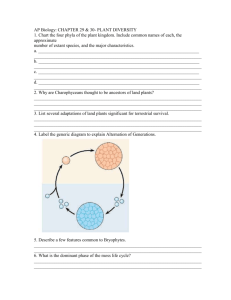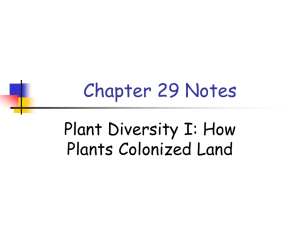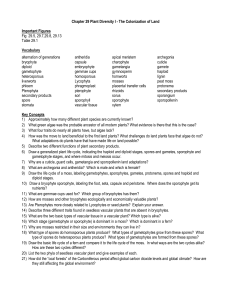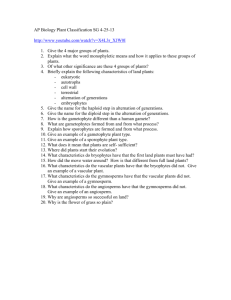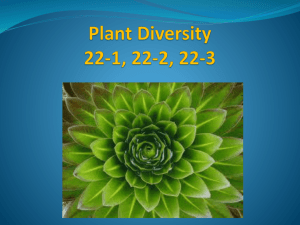Chapter 29
advertisement
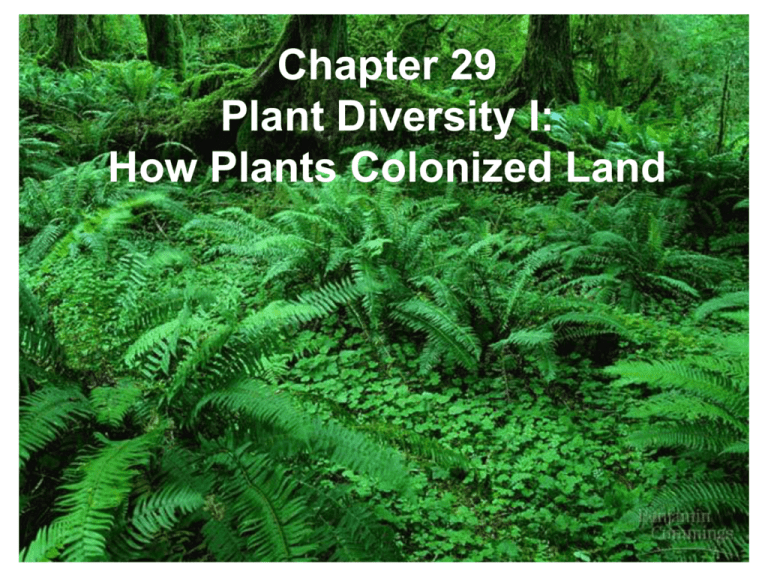
Chapter 29 Plant Diversity I: How Plants Colonized Land I. Overview of land plant evolution A. Four main groups of land plants Groups are distinguished from algae by reproduction (life cycle) that involves the development of a multicellular embryo attached to the mother plant for its protection and nourishment. B. Charophyceans are the green algae most closely related to land plants. 1. Both charophyceans and land plants are multicellular, eukaryotic, photoautotrophs. 2. Both have “rosette cellulose-synthesizing complexes”. Rosette cellulose-synthesizing complexes are rose-shaped arrays of proteins that synthesize the cellulose components that make up plant cell walls. 3. Presence of peroxisome enzymes. 4. Both have similarly flagellated sperm 5. Both use phragmoplasts when creating cell plates. Because all these features are shared between the groups, both land plants and charophyceans must have a common ancestor. Figure 29.2 (p. 578) – Charophyceans, closest algal relatives of the plant kingdom. (Fig. 29.3, Ed. 7) 1. Bryophytes – liverworts, hornworts, mosses Bryophytes do not have vascular tissues. - The next three groups are all vascular plants. Vascular plants have cells that are joined to produce tubes that transport water and nutrients throughout the plant. - Bryophytes live in damp/moist environments and are small so they don’t need vascular tissue. They are sometimes called non-vascular plants. - Algae that we saw in last chapter live in water and don’t need vascular tissue because nutrients come from surrounding water. The vascular plants are, in order of their evolution: 2. Pteridophytes – ferns, horsetails, lycophytes a. seedless plants 3. Gymnosperms – conifers, ginkgo a. early seed plants b. produce naked seeds 4. Angiosperms – flowering plants a. seeds protected by growing in ovaries b. majority of modern plants are in this group Figure 29.1 (p. 577, Ed. 6; Fig. 29.7, Ed. 7) – Some highlights of plant evolution. In order to grow on land, the land plants needed to evolve terrestrial adaptations to survive (pp. 576-577, Ed. 7). C. Terrestrial adaptations can be used to distinguish land plants from charophycean algae. These adaptations are: 1. Apical meristems a. Apical meristems are localized areas of cell division at tips of roots and shoots. Figure 29.3 (p. 579, Ed. 6) – Apical meristems of plant shoots and roots. 2. Multicellular, dependent embryos a. Embryo develops within female tissue; female plant provides nutrition (sugars, proteins). Figure 29.4 (p. 579, ed. 6; p. 577, ed. 7) b. Placental transfer cells that enhance the transfer of nutrients from the parent to the embryo. Figure 29.5 (p. 579, ed. 6; p. 577, ed. 7) 3. Alternation of generations Two multicellular body forms: a. Gametophyte (haploid) that produces gametes. Gametes fuse to form zygotes that develop into… b. Sporophytes (diploid) that produce spores. Spores are haploid cells that can develop into a new organism without fusing with another cell. Figure 29.6 (p. 580, ed. 6) – Alternation of generations: a generalized scheme. 4. Spore walls contain sporopollenin a. Sporopollenin is a polymer that makes the walls of plant spores very tough and resistant to harsh conditions. b. Sporopollenin is the most durable organic material known. c. Spores are produced by sporangia (cells in the sporophyte) through the process of meiosis. d. Durable spores are an adaptation for surviving on land. Can withstand long periods of adverse conditions. Easily transported by wind and water. Figure 29.7 (p. 580, ed. 6) – A fern spore. 5. Multicellular gametangia a. Gametangia are the gametophyte forms of bryophytes, pteridophytes, and gymnosperms. Gametes are produced within these organs. b. Female gametangia are called archegonia (produce and retain egg cells) c. Male gametangia are called antheridia (produce sperm) Figure 29.9 (p. 581) – Gametangia. 6. Other terrestrial adaptations common to many land plants a. Epidermis covered by a waxy cuticle to prevent excess loss of water. Pores (stomata) in cell layer can be opened and closed to allow O2 out and CO2 in. Figure 29.10 (p. 581, ed. 6) – Cuticle of a stem from Psilotum (a pteridophyte). b. Except for bryophytes, land plants have vascular tissue in roots, stems, and leaves. - Xylem consists of dead cells that carry water and nutrients from roots to the rest of the plant. - Phloem consists of living cells that distribute sugars and amino acids throughout the plant. Figure 29.11 (p. 582, ed. 6) – Xylem and phloem in the stem of Polypodium, a fern (a pteridophyte). II. Origin of land plants A. Theory is that land plants evolved from charophycean algae over 500 million years ago. Charophycean algae inhabit shallow waters and need to survive when water levels drop. Lead to increasing ability to survive entirely on dry land. B. Alternation of generations in plants may have originated by delayed meiosis Zygote Sporophyte Many, many spores 1. Occurs on land because it’s more difficult to produce zygotes. (No water for swimming sperm) 2. By producing sporophyte, many gametophytes can be produced from one zygote because many, many spores are produced. This maximizes output of sexual reproduction. III. Bryophytes A. Gametophyte is the dominant generation in the life cycles of bryophytes Figure 29.15 (p. 585, ed. 6) Figure 29.9 (p. 582, ed. 7) B. Life cycle of bryophytes Figure 29.16 (p. 586, ed.6) – The life cycle of Polytrichum, a moss. (Fig. 29.8, p. 581, ed. 7) 1. Bryophyte sporophytes produce and disperse huge numbers of spores. C. Ecological and economic benefits of bryophytes 1. Bryophytes were the world’s only plants for 100 million years. 2. Peat bogs are made mostly of moss called sphagnum. They contain 400 billion tons of carbon and cut down the amount of greenhouse gases. Peat is harvested, dried, and used as a fuel. 3. Sphagnum is harvested for use as a soil conditioner and plant packing material. Figure 29.19 (p. 588) – Sphagnum, or peat moss. IV. Origin of vascular plants - Pteridophytes = ferns - Gymnosperms = fir trees - Angiosperms = flowering plants A. Vascular plants evolved additional terrestrial adaptations 1. Xylem and phloem 2. Dominant sporophyte generation independent of the gametophyte Different from the bryophytes B. Cooksonia evolved over 400 million years ago oldest known vascular plant Figure 29.20 (p. 589) – Cooksonia, a vascular plant of the Silurian. V. Pteridophytes: seedless vascular plants Figure 29.21 (p. 590, ed. 6) – Examples of pteridophytes (seedless vascular plants). Called Pterophytes (Fig. 29.14, p. 587, ed. 7) A. Pteridophytes provide clues to evolution of roots and leaves 1. There is evidence that roots evolved from subterranean portions of stems. 2. There are two types of leaves: a. Leaves of lycophytes are microphylls. Microphylls are small leaves with a single, unbranched vein. b. Leaves of other modern vascular plants are megaphylls. Megaphylls are typically larger and have a branched vascular system. Figure 29.22 (p. 591, ed. 6; Fig. 29.13, p. 586, ed. 7) – Hypotheses for the evolution of leaves. B. Sporophyte-dominant life cycle evolved in seedless vascular plants (Pteridophytes) 1. Alternation of generations 2. Dominant sporophyte versus dominant gametophyte in bryophytes. 3. Plants are dispersed to new environments as spores; no seeds present Figure 29.23 (p. 592, ed. 6; Fig. 29.12, p. 585, ed. 7) – The life cycle of a fern. C. Importance of Pteridophytes 1. Dominant plants in Carboniferous period Figure 29.25 (p. 594, ed. 6; Fig. 29.15, p. 588, ed. 7) – Artist’s conception of a Carboniferous forest based on fossil evidence. 2. Extensive beds of coal from these plants
